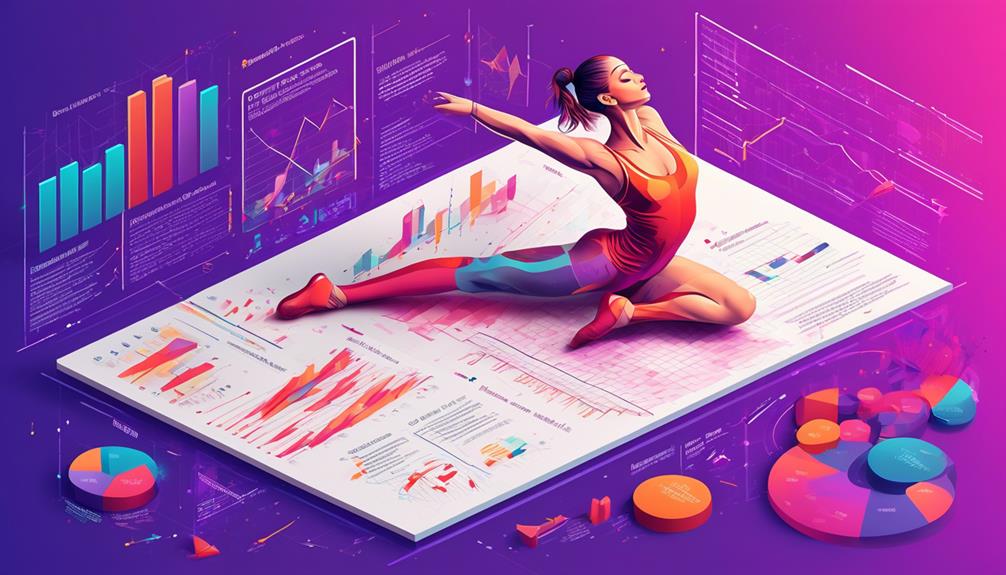Like a hidden treasure waiting to be discovered, dance statistics offer a glimpse into the intricate workings of the dance industry. As I sift through the numbers and figures, I uncover fascinating insights into the employment landscape, salary disparities, demographic representation, and the growth of dance studios.
The numbers paint a picture of an industry in flux, influenced by societal shifts and external factors. But what do these statistics reveal about the future of dance and the challenges it faces?
Key Takeaways
- The majority of professional dancers in the United States are women, with only 20.4% being men.
- California, Hawaii, Nevada, New York, and Texas are the top five states for dance-related employment.
- The average annual salary for professional dancers in the United States is $28,828, with men earning significantly more than women.
- The dance studio industry has experienced growth, with an increase in revenue and a positive outlook for the industry.
Employment Statistics
In the United States, the employment statistics for dancers and choreographers reveal a strong presence in performing arts companies, schools, and athletic spectatorships. These industries offer diverse opportunities for dancers, with colleges, universities, and professional dance schools being the highest-paying employers. The USA's workforce includes around 15,700 professional dancers, primarily comprising 79.6% women and 20.4% men. Although the gender gap is significant, both men and women contribute significantly to the dance workforce.
California, Hawaii, Nevada, New York, and Texas stand out as the top five states for dance-related employment, providing numerous job prospects for dancers and choreographers. The average annual salary for professional dancers in the United States is $28,828, with an average hourly rate of $16.31. These statistics offer valuable insights into the employment landscape for individuals pursuing careers in dance.
Understanding the distribution of dance employment across various industries and states is crucial for aspiring dancers and choreographers. These figures provide a realistic view of the job market, guiding individuals in making informed decisions about their career paths.
Salary Statistics
Professional dancers in the United States earn an average salary of $28,828 per year. However, there's a significant gender wage gap, with men earning an average of $42,551 annually, while women earn $25,312. It's important to address this disparity and strive for equal pay in the dance industry.
For those in companies, the yearly wage for dancers is similar to other non-dance-related jobs within the company. On an hourly basis, professional dancers make an average of $16.31.
When it comes to specific roles within the dance field, choreographers earn approximately $22.98 per hour, while dance instructors make around $20.98.
These figures provide insight into the financial aspects of a career in dance and emphasize the need to advocate for fair pay, particularly regarding gender disparities. Understanding these salary statistics is crucial for aspiring dancers and professionals to make informed decisions about their careers and advocate for equitable compensation in the industry.
Demographic Statistics
Let's talk about the demographics of the dance industry.
From age distribution to gender representation, there are several key points to consider.
Understanding the makeup of the dance workforce is essential for recognizing trends and addressing potential disparities.
Age Distribution
Reflecting a younger demographic in the dance workforce, the average age of dancers and choreographers in the USA is 28, with males averaging 31.8 and females averaging 27.1. The age distribution in the industry skews towards younger professionals, with the majority falling between 20 and 34.
This indicates a focus on growth and development opportunities for individuals in their 20s and 30s. Additionally, only about 6% of dancers and choreographers in the USA are over the age of 44, showing a smaller representation of older individuals in the field.
The dynamic and energetic nature of the industry is reflected in its age distribution, emphasizing a focus on youth and vitality.
Gender Representation
The gender distribution in the dance industry highlights a significant imbalance, with women comprising 79.6% of the workforce in the USA. This means that out of approximately 15,700 professional dancers and choreographers in the country, only about 3,200 are men.
Additionally, the representation of male dancers is only at 26.6%, indicating a heavily skewed gender ratio in this field. Despite this, male dancers earn a median income of $51,384, while female dancers earn a median income of $48,955, showing a slight disparity in earnings.
These statistics shed light on the gender disparities within the dance industry, and it's crucial to address these imbalances in order to create a more inclusive and equitable environment for all dancers.
Dance Studio Statistics
I've noticed a rising trend in the dance industry as the number of active dance studios in the USA continues to increase annually. This growth is indicative of the thriving dance community and the increasing interest in dance as an art form and recreational activity.
Here are some key statistics regarding dance studios:
- Annual Increase: There are about 68,393 active dance studios in the USA, and this number is on the rise each year. This signifies a growing demand for dance instruction and participation in various dance forms.
- Revenue Growth: The revenue in the dance studio industry has experienced a 4.6% increase in the last five years. This upward trajectory in revenue reflects the financial viability of the dance studio business and its ability to attract clientele.
- Community Impact: The expansion of dance studios contributes to the cultural and artistic enrichment of local communities. It provides individuals, especially children and young adults, with opportunities for creative expression, physical activity, and social engagement.
The increasing presence and financial success of dance studios indicate a positive outlook for the dance industry, fostering an environment where individuals can explore their passion for dance while contributing to the economic and cultural landscape.
Injury and Health Statistics

With the physical demands of their profession, dancers and choreographers often encounter injuries and illnesses, making health statistics a crucial aspect of the dance industry.
The average age of dancers and choreographers in the USA is 28, with females comprising 79.6% of the workforce. These professionals may experience injuries and illnesses due to the physical demands of their work.
Despite the challenges, the median hourly wage for choreographers was $30.72 in May 2022, while dancers earned a median hourly wage of $19.96.
It's important to note that employment of dancers and choreographers is projected to grow by 5 percent from 2022 to 2032. This growth suggests an increasing demand for these professionals, which also underscores the significance of understanding and addressing the injury and health statistics within the dance industry.
As a dancer myself, I recognize the importance of staying informed about the potential health risks in this field and taking proactive measures to maintain physical well-being. These statistics serve as a reminder of the need for prioritizing health and safety in the dance profession.
Choreography and Performance Statistics

When it comes to choreography and performance statistics, one can't help but wonder about the latest trends in choreography. The success rates of performances and the data on audience engagement are also important factors to consider. These points will shed light on the evolving nature of dance and the impact it has on both performers and audiences.
Choreography Trends
Choreography trends in the dance industry reflect evolving artistic expressions and movement styles embraced by performers and audiences alike.
- Fusion of styles: There's a growing trend of blending traditional dance forms with contemporary movements, creating innovative and diverse choreographic styles.
- Emphasis on storytelling: Choreographers are increasingly focusing on creating narratives through movement, using dance as a means of storytelling to engage and connect with audiences on a deeper level.
- Collaborative choreography: There's a rise in collaborative choreography, with dancers and choreographers working together to co-create pieces, fostering a sense of collective creativity and inclusivity within the dance community.
These trends not only shape the creative landscape of dance but also contribute to the dynamic and ever-evolving nature of the art form.
Performance Success Rates
As dance choreography trends continue to evolve, the performance success rates and statistics for both choreographers and dancers play a crucial role in understanding the industry's dynamics.
The average salary for professional dancers is $28,828 per year, with an average hourly rate of $16.31. For choreographers, the median hourly wage was $24.52 in May 2022.
Looking ahead, employment of dancers and choreographers is projected to grow by 5% from 2022 to 2032. Additionally, the dance studio industry market size experienced a 3% annual growth from 2015 to 2020.
These statistics shed light on the financial aspects of the dance industry, indicating opportunities for growth and career advancement.
Understanding these performance success rates is crucial for both aspiring and established professionals in the field.
Audience Engagement Data
Engaging with audience data is essential for both choreographers and performers to gauge the impact of their work on viewers. Understanding audience engagement data can help in creating more impactful and resonant dance performances.
Here are three crucial aspects of audience engagement data:
- Audience retention: This metric measures the percentage of viewers who stay engaged throughout the entire performance, indicating the level of interest and captivation.
- Reaction: Tracking audience reactions such as smiles, nods, and emotional responses provides valuable insights into the effectiveness of the performance in eliciting desired emotions.
- Participation: Metrics like applause duration, audience feedback, and social media shares reflect the level of engagement and interaction with the performance, indicating its resonance with the audience.
Industry Revenue and Growth Statistics

With a 4.6% increase in revenue over the last five years, the dance studio industry has demonstrated steady growth. This trend is further supported by the significant presence of approximately 68,393 active dance studios in the United States. The industry not only offers artistic and cultural value but also provides substantial financial opportunities, with dance studio owners earning an average salary of $67,000 per year. Moreover, the economic impact of the industry is underscored by the average annual revenue of $150,000 per dance studio. This data reflects a thriving industry with promising financial prospects.
To provide a clear overview of the industry's key statistics, the table below outlines essential figures, from the industry's revenue growth to the average annual revenue of dance studios:
| Statistic | Figure |
|---|---|
| Revenue growth over the last five years | 4.6% |
| Number of active dance studios in the US | 68,393 |
| Average annual salary of dance studio owners | $67,000 |
| Average annual revenue of dance studios | $150,000 |
These figures collectively showcase the robust financial landscape and growth potential within the dance studio industry.
Frequently Asked Questions
What Are the Most Popular Dance Styles in Terms of Audience Attendance and Participation?
The most popular dance styles in terms of audience attendance and participation include ballet, hip-hop, jazz, contemporary, and tap. Each style has its unique appeal and draws in a diverse range of people.
How Do Dance Trends Vary by Region or Country?
Dance trends vary by region or country due to cultural influences and historical traditions. Globalization and digital media have facilitated the spread and fusion of dance trends across regions, leading to cross-cultural influences and international adaptations.
What Are the Most Common Injuries Sustained by Dancers and How Do They Affect Their Careers?
The most common injuries sustained by dancers are sprains, strains, and overuse injuries, often affecting the lower extremities and back. These injuries can impact a dancer's career by causing performance limitations, time off for recovery, and potential long-term physical consequences.
Are There Any Statistics on the Impact of Dance on Mental Health and Well-Being?
Can dance improve mental health? Studies show dance reduces stress and anxiety, boosts mood, and enhances self-esteem. Research suggests it may help combat depression and promote overall well-being.
How Do Social Media and Digital Platforms Impact the Dance Industry and Its Growth?
Social media and digital platforms revolutionize the dance industry, expanding reach, fostering community, and creating new career opportunities. They enable global exposure for dancers, choreographers, and studios, shaping trends and driving growth.
Conclusion
After exploring dance statistics, I was surprised to learn that women make up nearly 80% of the dance workforce, yet earn significantly less than their male counterparts.
This disparity sheds light on the gender pay gap in the industry.
It's clear that there's still work to be done to achieve equality in dance.










